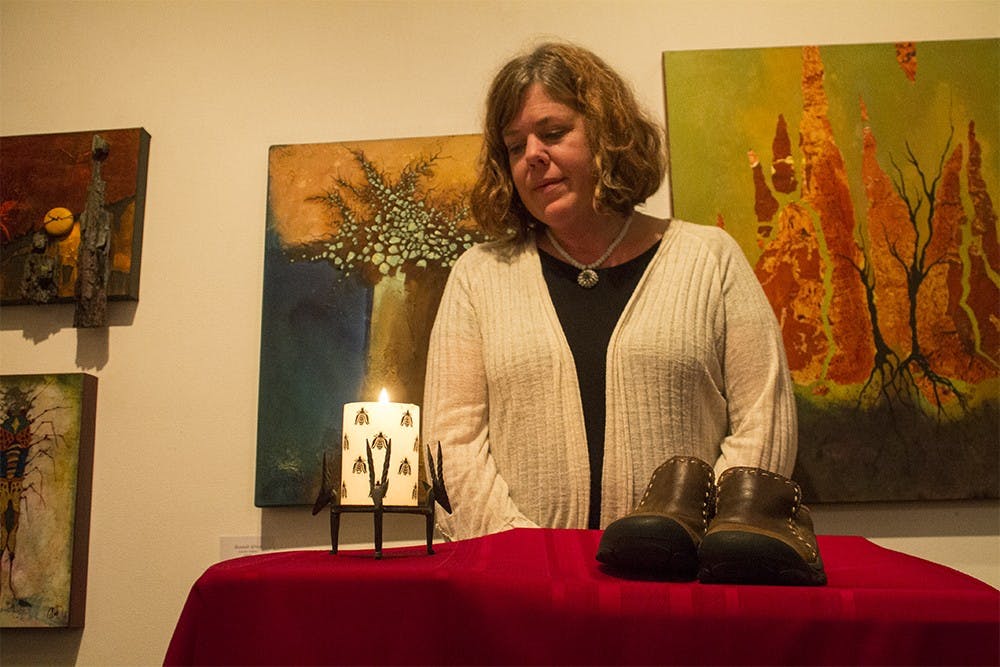The gallery lights were dimmed, the chairs were set in a semicircle around a small table with a red cloth. On the right side of the table sat a pair of black shoes. In the middle was a gold clock, frozen in time. People sat, faces sullen, as they anticipated what would come.
At the left of the table sat a candle, which Dave Colman lit after a brief introduction.
“In My Shoes” was the final event in a series put on by the Venue Fine Art & Gifts in honor of National Suicide Prevention Month. Survivors and those affected by suicide spoke Tuesday night.
“I’ve learned from this presentation that suicide affects the lives of one in five people in this country. I’ve learned that more people died this year from suicide than from auto accidents,” Colman, curator of the Venue, said.
After Colman’s introduction, a recording played. The voice of Michelle Martin-Colman, Colman’s wife, came clearly through the speaker. She read from a letter.
“When I close my eyes, I remember hearing you on an early fall day like this, many years ago, when I was eight,” Martin-Colman said on the recording. “I would hear you whistling on the sidewalk every morning at 7:30 on your way to work. You were the silver-haired stepfather who adopted me and eventually became my dad.”
Martin-Colman went on to outline her step-father’s life, from the strict rules about who she could play with and unhealthy habits of smoking and scotch, to the happier times with her brothers — the combined family.
After a heart attack and the loss of his job, Martin-Colman said her stepfather grew increasingly less satisfied in his life. She said she could see the markers for unhappiness, though no one knew at the time how to address them.
One day in 1977, he told his family he was going on a trip with friends. Four days later, the call came that he had died of an overdose in a hotel room.
“I can’t remember if I called to talk with you before I left — before you left,” Martin-Colman said. “Regardless, because I sensed you would take your own life at some point, I always felt I should have — could have — done more to stop you. Over the years I have written many letters to you, and today, looking at your clock, at this event which you inspired, I like this letter the best.”
After the first recording ended, Colman blew the candle out. He placed another, a white one with a black pattern, and a pair of brown shoes with tan stitching atop the table.
Colleen Wells’ voice recording played next. The author, who spoke at the Venue last year, wrote a book about her struggles with bipolar disorder. That night, she shared another memory from her time in college, when she struggled with suicidal thoughts.
“I had seen a movie about two teenagers killing themselves by sitting in a running car inside of a closed garage,” Wells said on the recording. “When I tried this, I was not sure in my 18-year-old mind that I truly wanted to die, because I left the window cracked and I knew my aunt, who was visiting, was inside.”
Wells reflected on all she never would have done had she successfully ended her life, including meeting her husband, adopting children and sharing memories with loved ones. She said she still reads the letters she received while in the hospital and said they give her the strength to continue seeking the beauty in life.
The next speaker was artist Mark Riggins, who placed his own shoes on the table in honor of a former coworker. He recalled how one day during work, he received a call from a suicide hotline warning that one of his colleagues was at risk. He sought out the employee, spoke to him for an hour or so and said they stayed in touch afterward.
Cindy Moore, coordinator of academic advising in the School of Public Health, spoke last. She shared the experience of losing her oldest nephew to suicide in 2010 and how that experience encouraged her to take an active role in the discussion.
Moore participates in safeTALK workshops, part of an initiative to prepare people to be more alert and aware of the markers of suicide in those around them. Terminology is important to change the dialogue surrounding the act of suicide, which Moore said is not discussed enough as a disorder.
“Oftentimes when people speak about someone who has died by suicide, it’s quite common to see the word ‘committed’ suicide,” Moore said. “We just don’t talk about it. One of the things we try to talk about and promote during safeTALK presentations is getting away from the word ‘committed.’”






